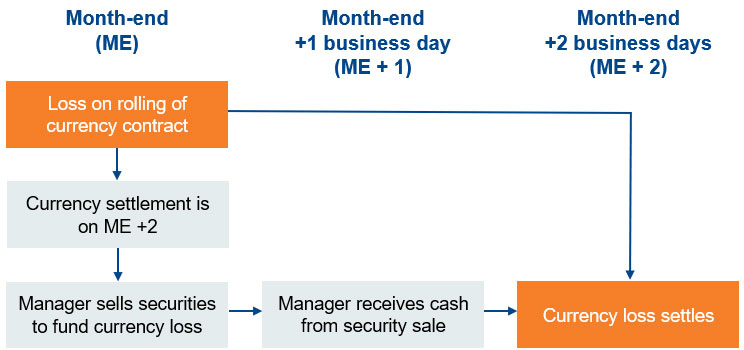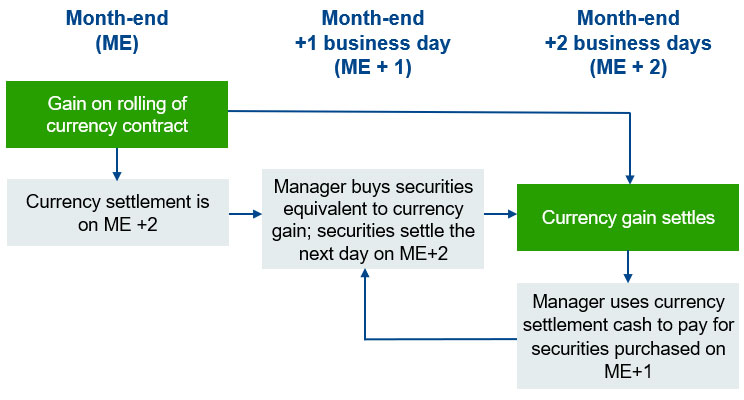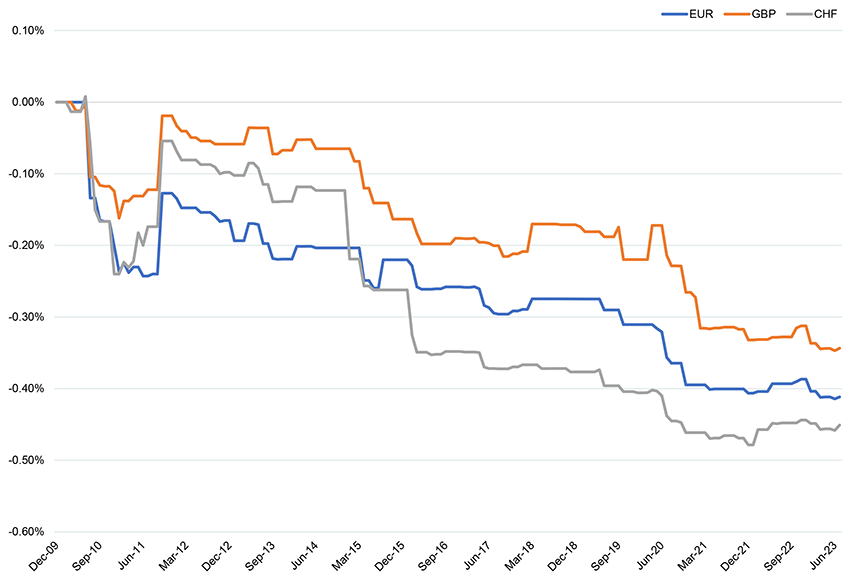Insights
The future for hedged share class investors: Futures overlays
Share this article
October 19, 2023 | By Mesirow Currency Management
Security settlements will happen faster in the United States next year. The exchange of securities and cash will shorten from two days after trading to one day. That shorter cycle complicates the process for many investors, and foreign investors using hedged share classes face additional hurdles.
Beginning May 28, 2024, the US Securities and Exchange Commission will require settlement of US security transactions one day after trading. Reducing the settlement time from the current two days to one day will be challenging for US investors, and foreign investors may find the shorter settlement to be even more demanding. For purchases of US securities, foreign investors will need to coordinate the security deal with a currency transaction to make sure that US dollars are available to pay for the securities. Some investment managers and investors who use hedged share classes will face additional hurdles.
A hedged share class is useful for managing the currency risk inherent in international investments. The risk arises from owning a security denominated in a foreign currency. A foreign investor who invests in US securities will have an investment outcome (profit or loss) that depends not only on changes in the US security price but also on changes in the USD – foreign currency exchange rate.
Hedged share classes work like this: A foreign investor invests in the hedged share class with its home currency. The hedged share class investment manager sells the investor’s currency to buy USD to purchase US shares. Simultaneously, the investment manager sells USD forward to hedge the currency risk. The purchase of USD (to buy the US securities) and sale of USD (as part of the currency forward or hedge) offset, neutralizing the effect of changes in the US dollar exchange rate versus the investor’s home currency.
In the currency market, the typical exchange of currencies is two business days after trading (commonly described as T+2). Next May, hedged share class investment managers will need to trade foreign exchange promptly after security trading so that dollars are available to fund US securities purchases.
Additionally, at the end of each month the investment manager will need to renew, or roll, the currency forward contract. Rolling involves closing the existing contract resulting in a profit or loss. The investment manager then opens a new currency forward contract for the next month. If closing last month’s currency contract results in a loss, the actions and timeline would look like this:
FIGURE 1: LOSS ON ROLLING OF CURRENCY CONTRACT

At month-end, if rolling currency contract results in a loss then currency settlement is two days after month-end. The managers sells securities to fund currency loss at month-end, then receives cash one day after month-end.
Source: Mesirow Currency Management
We assumed stocks could be liquidated to fund a loss on the currency contract and that the investment manager could hold cash for a day.
If closing the currency forward results in a gain, then the situation would look like this:
FIGURE 2: GAIN ON ROLLING OF CURRENCY CONTRACT

At month-end, if rolling currency contract results in a gain then currency settlement is two days after month-end. The managers buys securities equivalent to the currency gain one day after month-end.
Source: Mesirow Currency Management
To be fully invested, the manager would prefer to buy securities at month end (ME); settlement of those securities would be on ME+1 business day, but cash from the currency settlement, needed to pay for the securities, would not be available until ME + 2 business days. Thus, the investment manager must delay the reinvestment of those currency gains for one day.
What’s the investment impact of leaving that gain uninvested for one day? The answer depends on when the investment manager invests the cash. Strategies available for purchasing securities on ME+1:
buy at market open
buy at market close
use a trading plan such as a volume-weighted-average price strategy. For discussion, we’ll use an average share price calculated from the securities’ high and low values on ME+1.
We assume the securities are equities represented by the S&P 500 index. Table 1 presents the equity gains or losses for holding cash for one day.
TABLE 1: ONE-DAY EQUITY OUTCOMES GIVEN VARIOUS INVESTMENT STRATEGIES, BASIS POINTS
| S&P 500 Open Price | S&P 500 Close Price | S&P 500 Average Price | |||||||
| EUR | GBP | CHF | EUR | GBP | CHF | EUR | GBP | CHF | |
| Maximum | 2.1 | 2.5 | 1.9 | 11.3 | 10.3 | 12.0 | 6.5 | 5.9 | 6.9 |
| Minimum | -3.3 | -3.0 | -2.9 | -13.4 | -10.2 | -9.6 | -8.7 | -6.6 | -4.8 |
| Average | -0.1 | -0.1 | -0.1 | -0.3 | -0.2 | -0.3 | -0.2 | -0.1 | -0.1 |
| Risk | 1.9 | 2.0 | 1.7 | 5.8 | 5.5 | 6.4 | 3.8 | 3.8 | 3.9 |
Source: Bloomberg and Mesirow Currency Management | Notes: 1. EUR = Euro GBP = British pound CHF = Swiss franc | 2. Risk is annualized standard deviation
The largest gains and losses occurred when the securities were purchased at the closing price on ME+1. The smallest variation between the maximum and minimum prices occurred when securities were purchased at the opening price. The average loss over the analysis period for all three strategies was slightly negative and close to zero.
Table 2 shows that during the analysis period (January 2010 to July 2023; 163 months), the currency hedge was profitable from 46% (EUR 75/163) to 52% of the time (CHF: 84/163). In that same period, the securities purchased at the market close on ME+1 lost value compared to the previous day’s closing price about 56% of the time.
TABLE 2: FREQUENCY OF CURRENCY HEDGE PROFIT AND SECURITY LOSSES USING ME+1 CLOSING PRICE STRATEGY, MONTHS
| Currency | EUR | GBP | CHF |
| Profit on currency hedge | 75 | 76 | 84 |
| Security loss due to equity movement | 42 | 43 | 46 |
| Percentage (security loss / currency profit) | 56.0% | 56.6% | 54.8% |
Source: Bloomberg and Mesirow Currency Management
Figure 3 shows the extent of the security losses. The cumulative return from the market close on ME to the market close on ME+1 during the analysis period was between 34 and 45 basis points.
The cumulative loss could be reduced with a one-day futures overlay on ME+1. The overlay would result in a gain about 44% of the time, reducing the cumulative loss.
FIGURE 3: CUMULATIVE RETURN – CLOSE ON ME TO CLOSE ON ME+1 (DECEMBER 2009 – JULY 2023)
 Cumulative loss at close on month-end to close on month-end plus one business day December 2009 to July 2023 for EUR, GBP and CHF
Cumulative loss at close on month-end to close on month-end plus one business day December 2009 to July 2023 for EUR, GBP and CHF
Source: Bloomberg and Mesirow Currency Management
Hedged share class investors must decide how to manage the upcoming mismatch between settlement cycles: T+1 for securities and T+2 for foreign exchange. Investors can
Use excess portfolio cash to purchase shares on ME+1. However, holding excess cash means the investor is not fully invested; that can lead to cash drag on the portfolio.
Change the settlement date of the currency hedge to ME+1 to align with the equity settlement. Settling large currency forward positions on a T+1 cycle is unconventional and could result in additional risk. And early settlement on T+1 could incur additional settlement costs compared to the standard T+2 settlement that is part of the hedged share class benchmark methodology.
Overlay the currency hedge profit with equity futures for one day. The investor will need cash for collateral, but it will be a small fraction, such as ~5%, of the futures amount.
Mesirow can help investors with their currency hedging needs in these changing times, whether standalone currency overlay or hedged share classes. We can also offer futures overlays to complement your currency overlay or address issues such as the T+1 changes that are imminent.
Questions about the upcoming T+1 settlement change or managing hedged share classes, currency hedging, or futures overlays? Contact Joe Hoffman, CEO, Currency Management at 312.595.7019 or joseph.hoffman@mesirow.com.
Explore more currency insights
An armed war and a currency battle
Russia confronts the US dollar with so-so results.
USD and the BRICS threat
Sanctions on Russia lead to a call for a new currency to compete with the USD. Is a common currency likely?
Spark
Our quarterly email featuring insights on markets, sectors and investing in what matters
